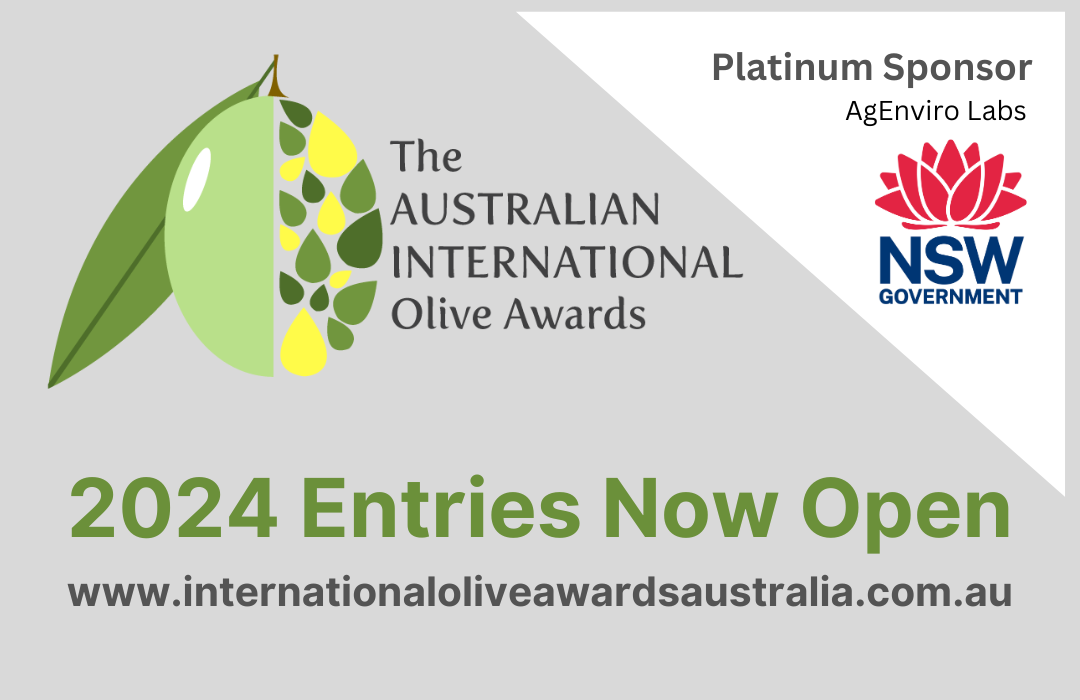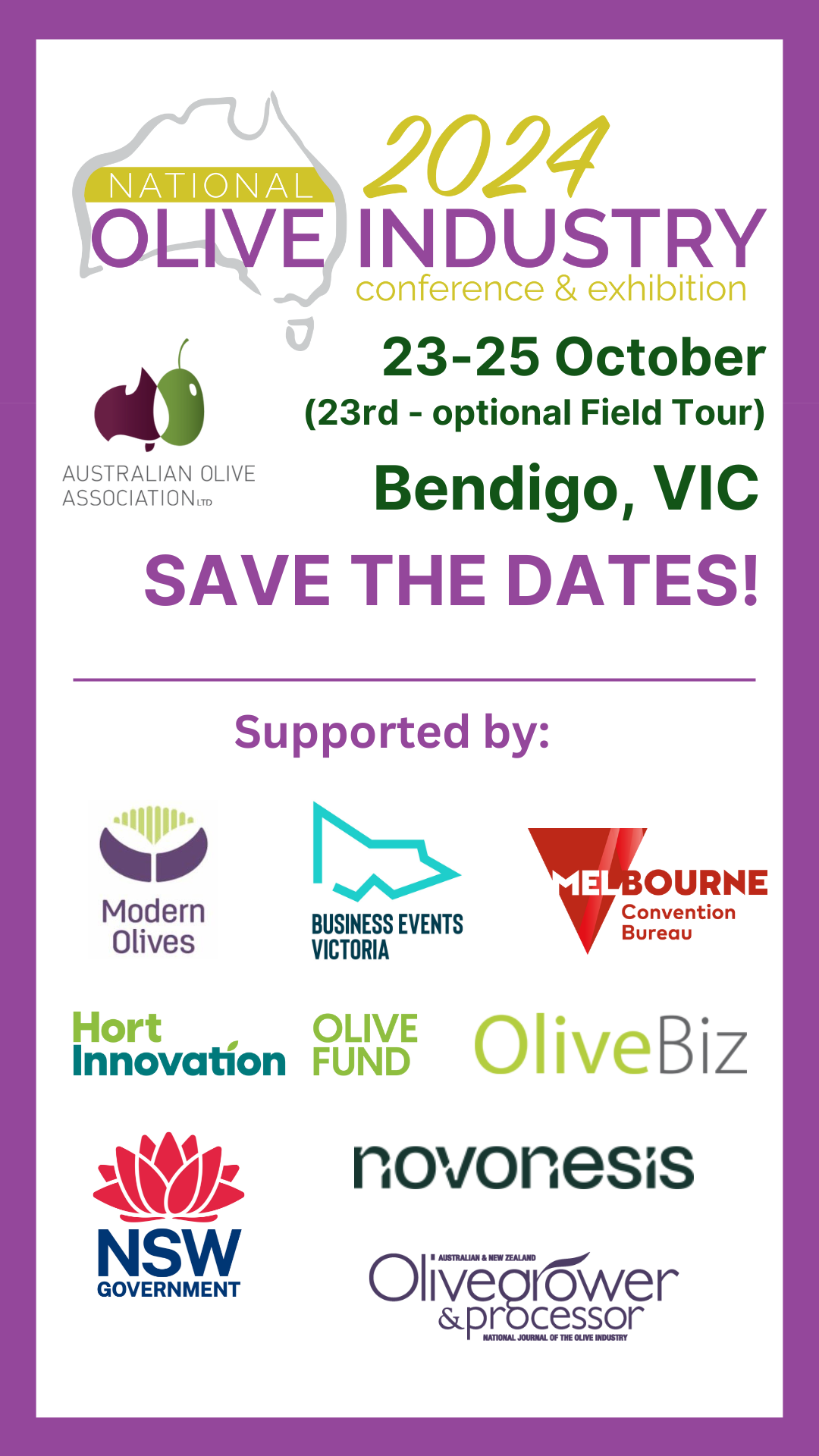BIOSECURITY RISK MANAGEMENT
27/07/2021
On-farm biosecurity best practices play a pivotal role in maintaining Australia’s reputation for producing high quality products.
BIOSECURITY: WHAT IS IT AND HOW CAN I BENEFIT?
Plant biosecurity is a series of measures that aid in protecting production areas from harmful insects, weeds, and various plant diseases. They are collectively referred to as ‘plant pests,’ that have the potential to adversely affect plant health.
The Biosecurity Plan for the Olive Industry outlines key threats to the industry, risk mitigation plans, identification and categorisation of exotic pests and contingency plans.
On-farm biosecurity best practices play a pivotal role in maintaining Australia’s reputation of producing high quality products. Growers maintaining a pest-free environment can capitalise on this reputation and use it as a trade asset to gain leverage into global and local markets. Additionally, biosecurity practices can act as security against farm quarantine measures.
Proper biosecurity signage; insect, weed and pest surveillance; and on-farm clean-down facilities are three commonly used farm biosecurity measures.

BIOSECURITY BEST PRACTICE CHECKLIST:
- Manage biosecurity risks – prepare an on-farm biosecurity plan
- Plant disease resistant varieties and avoid planting in infected soils.
- Know your high priority biosecurity pests – induct your employees
- Monitor your grove – report anything unusual to the exotic pest hotline
- Implement good grove hygiene – keep it clean, removal or composting of pruning wood, disinfection of pruning tools
- Enforce visitor movement requirements – people and vehicles
- Use grove biosecurity signage
- Provide vehicle and fruit bin wash down facilities – arrive clean / leave clean
KEY BIOSECURITY RISKS
An industry observation is that the top 3 biosecurity / plant health threats to Australian horticulture are:
- Movement of machinery and workers on and off groves eg Olive Lace Bug – if we can’t get this right with known pests and risks what hope do we have if Olive quick decline (Xylella fastidiosa subsp. pauca ) enters Australia?
- Propagation and distribution of nursery stock without adopting adequate plant health protocols (especially for fungal and bacterial diseases) – this includes other host species that may be sourced by your neighbours.
- Illegal importation of plant material to gain an economic advantage – selfish behaviour!
Note to olive growers: Do you always source certified disease free olive trees?
THE BIOSECURITY BACK OFFICE
The Australian Olive Association Ltd (AOA) is working closely with Plant Health Australia (PHA) on industry biosecurity planning processes, fostering olive industry biosecurity threat awareness and preparedness, and industry response to incursions of exotic pests and diseases.
AOA is a signatory to the Emergency Plant Pest Response Deed (EPPRD), a government / industry cost sharing agreement that lies at the heart of the industry-government partnership arrangement for plant biosecurity and incursion management. The AOA Board has received training on its responsibilities under the EPPRD.
The National Management Group (NMG) is responsible for making key decisions on national biosecurity policy and resourcing in a response to an Incident under the EPPRD. The NMG comprises representatives from all Affected Parties for a particular Biosecurity Incident, who are authorised to bind that Party under the EPPRD, and PHA. The Olive Industry representative on the NMG is AOA CEO.
The Consultative Committee on Emergency Plant Pests (CCEPP) is Australia’s key technical body for coordinating national responses to emergency plant pest (EPP) incursions (around 5 per month), and assessing the technical feasibility for their eradication. AOA’s representative on the CCEPP is the OliveCare® Administrator.
PLANTPLAN (Australian Emergency Plant Pest Response Plan; current version as of 30 November 2018) is the agreed technical response plan used to respond to an emergency plant pest incident. It provides nationally consistent guidelines for response procedures under the Emergency Plant Pest Response Deed (EPPRD), outlining the phases of an incursion, as well as the key roles and responsibilities of industry and government during each of these phases. It incorporates best practice in emergency plant pest responses is updated regularly to incorporate new information or address gaps identified by the outcomes of emergency plant pest incident reviews.
http://www.planthealthaustralia.com.au/wp-content/uploads/2018/11/PLANTPLAN-30-November-2018.pdf
THE BIOSECURITY PLAN FOR THE OLIVE INDUSTRY
The Biosecurity Plan for the Olive Industry (OBP) Version 2.0 October 2016, provides a framework for the olive industry, government and other relevant stakeholders to determine pests of highest priority, analyse the risks they pose, and put in place procedures to reduce the chance of pests becoming established, and minimise the impact if a pest incursion occurs.
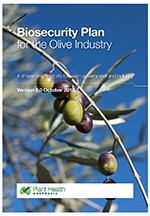
Download Biosecurity Plan for the Olive Industry here
HIGH PRIORITY OLIVE PESTS AND DISEASES
The Biosecurity Plan for the Olive Industry identifies the following 5 high priority exotic pests and diseases of olives:
- Olive fly (Bactrocera oleae)
- Olive moth (Prays oleae)
- Leaf scorch (Xylella fastidiosa subsp. multiplex with vectors)
- Olive quick decline (Xylella fastidiosa subsp. pauca with vectors)
- Verticillium wilt (Verticillium dahliae –exotic defoliating strains) – already in Australia present on cotton!
Would you be able to recognise these exotic pests & diseases if they appeared in your grove?
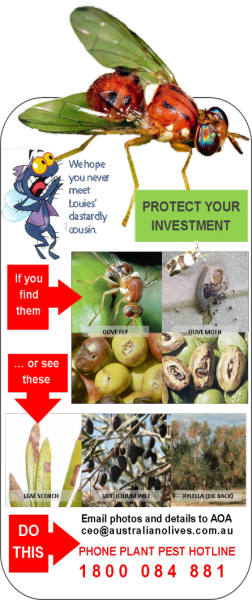
FARM BIOSECURITY ACTION PLAN FOR OLIVE GROWERS

Download Farm Biosecurity Action Plan for Olive Growers here
ON-FARM BIOSECURITY AWARENESS & PREPAREDNESS:
Six easy ways to protect your property:
Don’t put your livelihood at risk by neglecting orchard biosecurity.
- Be aware of biosecurity threats
Make sure you and your orchard workers are familiar with the most important exotic olive pest threats. Conduct a biosecurity induction session to explain required hygiene practices for people, equipment and vehicles in your orchard.
- Use pest-free propagation material
Ensure all propagation material is from trusted sources and orchard inputs are fully tested, pest-free and preferably certified. Keep good records of your orchard inputs.
- Arrive Clean – Leave Clean
Practicing good sanitation and hygiene will help prevent the entry and movement of pests onto your property. Workers, visitors, vehicles and equipment can spread pests, so make sure they are clean before entering and leaving your property. Have a designated visitor’s area and provide vehicle and personnel wash-down facilities.
Download Vehicle Cleaning Fact Sheet here
- Check your orchard
Monitor your trees frequently. Knowing the usual appearance of your orchard and trees will help you recognise new or unusual events and pests. Keep written and photographic records of all unusual observations. Constant vigilance is vital for early detection of any exotic plant pest threat.
- Abide by the law
Respect and be aware of laws and regulations established to protect the olive industry, Australian agriculture, and your region.
- Report anything unusual
If you suspect a new pest – report it immediately to the Exotic Plant Pest Hotline: 1800 084 881
Don’t put your livelihood at risk by neglecting orchard biosecurity.
ENFORCE VISITOR REQUIREMENTS
Download Farmgate Biosecurity Signage Fact Sheet here: https://ausveg.com.au/app/
The following are suggested general requirements for managing visitors on farm to limit the biosecurity risk that they pose.
- Place a sign at all property entry points requesting all visitors to report to the office before progressing into other areas of the site.
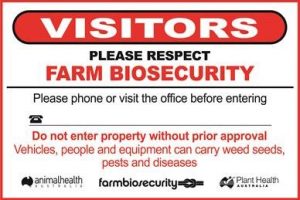
- Details of each visitor must be recorded in the ‘Visitor Record’.
- Designated staff, visitor parking and delivery / pick-up points must be separated from production area(s).
- Visitors entering the production area such as customers, contractors, crop consultants or sales representatives must be free of contaminants that could carry plant pests such as soil and vegetative material, where appropriate provide foot-baths, boot covers or request clean boots, etc.
- Restrict unnecessary movement of visiting machinery, vehicles, equipment and people into the production area.
- Any vehicles or equipment going into the production area must be checked (in a low risk area) for organic matter including soil, crop residue, weed seeds, live pests and possible diseased host material.
- Provide access to vehicle wash-down facilities will be available for high risk machinery including mechanical pruners and harvesters.
NSW BIOSECURITY MANAGEMENT PLANS – SAFEGUARDING YOUR PROPERTY:
NSW Producers are being urged to adopt a Biosecurity Management Plan (BMP) to reduce biosecurity risks and increase protection against trespasses.
A BMP provides an effective tool to help producers document all the biosecurity risks to their property and includes a wide range of activities and plans to prevent and help manage various pests and diseases. Arrangements in BMPs aim to prevent and minimise the biosecurity risks posed by people entering any property where commercial agricultural or horticultural activity, including processing and education, occurs.
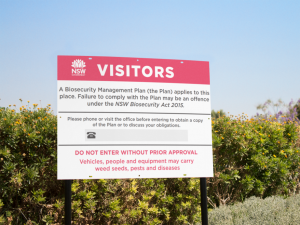
Signs must be displayed at the entrance to the management area to which your plan applies.
NSW landholders may make their own signs by downloading and printing the PDF here
THE EXOTIC PLANT PEST HOTLINE
Calls to the Exotic Plant Pest Hotline will connect to an automated system that allows the caller to choose the state or territory that the call relates to. The caller will then be connected to the relevant authority for that jurisdiction where calls will be answered by an experienced person, who will ask some questions to help understand the situation, such as:
- what was seen (describe the pest or send a photo) and when was it first noticed
- where it was found and what it was on
- how many pests are present/how infected is the crop
- how widely distributed it is.
Every report will be taken seriously, checked out and treated confidentially.
If you suspect a new pest, call the Exotic Plant Pest Hotline



